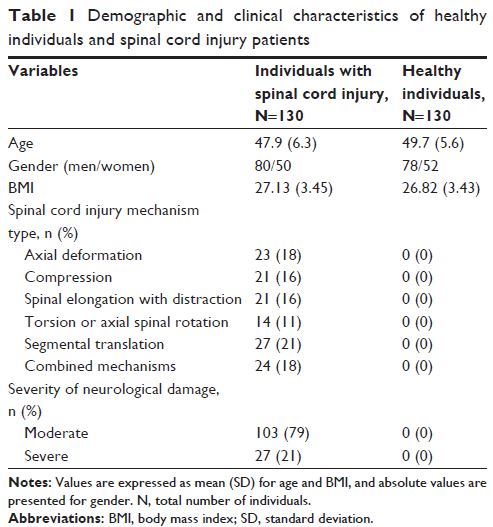108384
论文已发表
注册即可获取德孚的最新动态
IF 收录期刊
- 3.4 Breast Cancer (Dove Med Press)
- 3.2 Clin Epidemiol
- 2.6 Cancer Manag Res
- 2.9 Infect Drug Resist
- 3.7 Clin Interv Aging
- 5.1 Drug Des Dev Ther
- 3.1 Int J Chronic Obstr
- 6.6 Int J Nanomed
- 2.6 Int J Women's Health
- 2.9 Neuropsych Dis Treat
- 2.8 OncoTargets Ther
- 2.0 Patient Prefer Adher
- 2.2 Ther Clin Risk Manag
- 2.5 J Pain Res
- 3.0 Diabet Metab Synd Ob
- 3.2 Psychol Res Behav Ma
- 3.4 Nat Sci Sleep
- 1.8 Pharmgenomics Pers Med
- 2.0 Risk Manag Healthc Policy
- 4.1 J Inflamm Res
- 2.0 Int J Gen Med
- 3.4 J Hepatocell Carcinoma
- 3.0 J Asthma Allergy
- 2.2 Clin Cosmet Investig Dermatol
- 2.4 J Multidiscip Healthc

聚 ADP 核糖聚合酶-1 在中国人脊髓损伤发病中的作用:一项中国临床研究
Authors Meng Q, Yang G, Li R, Nie J, Zhou W, Yu H, Chen B, Jiang L, Shang J
Received 17 May 2017
Accepted for publication 18 September 2017
Published 6 December 2017 Volume 2017:11 Pages 3491—3495
DOI https://doi.org/10.2147/DDDT.S142005
Checked for plagiarism Yes
Review by Single-blind
Peer reviewers approved by Dr Junhua Mai
Peer reviewer comments 3
Editor who approved publication: Dr Qiongyu Guo
Objective: We aimed to evaluate whether
the polymorphism of poly(ADP-ribose) polymerase-1 (PARP-1) is involved as
potential risk factor in the development of spinal cord injury (SCI) among
Chinese individuals.
Patients and methods: Patients with a confirmed diagnosis of SCI (other than
traumatic injury) and healthy individuals with no clinical symptoms of SCI were
enrolled at Spinal Cord Injury Care Center, The Third People’s Hospital of
Dalian, China. Genetic polymorphisms were studied in plasma samples by
polymerase chain reaction-restriction fragment length polymorphism assay.
Results: A total of 130 Chinese patients with SCI and 130
healthy Chinese individuals were included. We found that patients with the GG
genotype (odds ratio [OR]: 4.09, 95% confidence interval [CI] 2.42–6.90, P <0.001) and carriers of the G
allele (OR 3.96, 95% CI 2.33–6.74, P <0.0001)
were at high risk of developing SCI. A del/ins polymorphism of the NF-κB1 gene (OR
3.32, 95% CI 1.96–5.61, P <0.001) was
also found to be associated with SCI.
Conclusion: Our study suggests that PARP-1 polymorphisms are
involved in the development of SCI in Chinese individuals. Thus, PARP-1
polymorphisms can be considered as one of the potential risk factors for
developing SCI.
Keywords: spinal cord
injury, poly(ADP-ribose) polymerase-1, polymorphism
